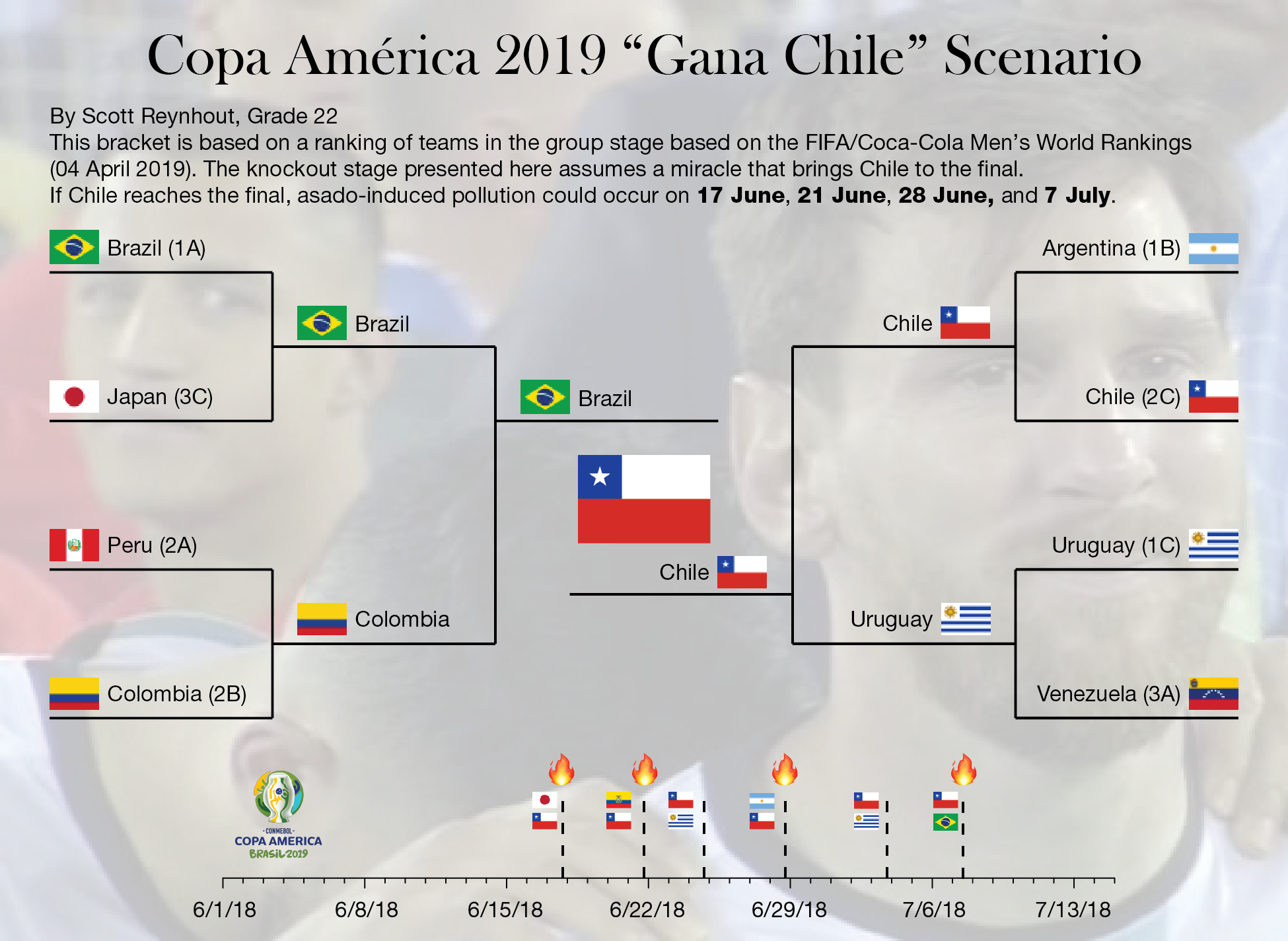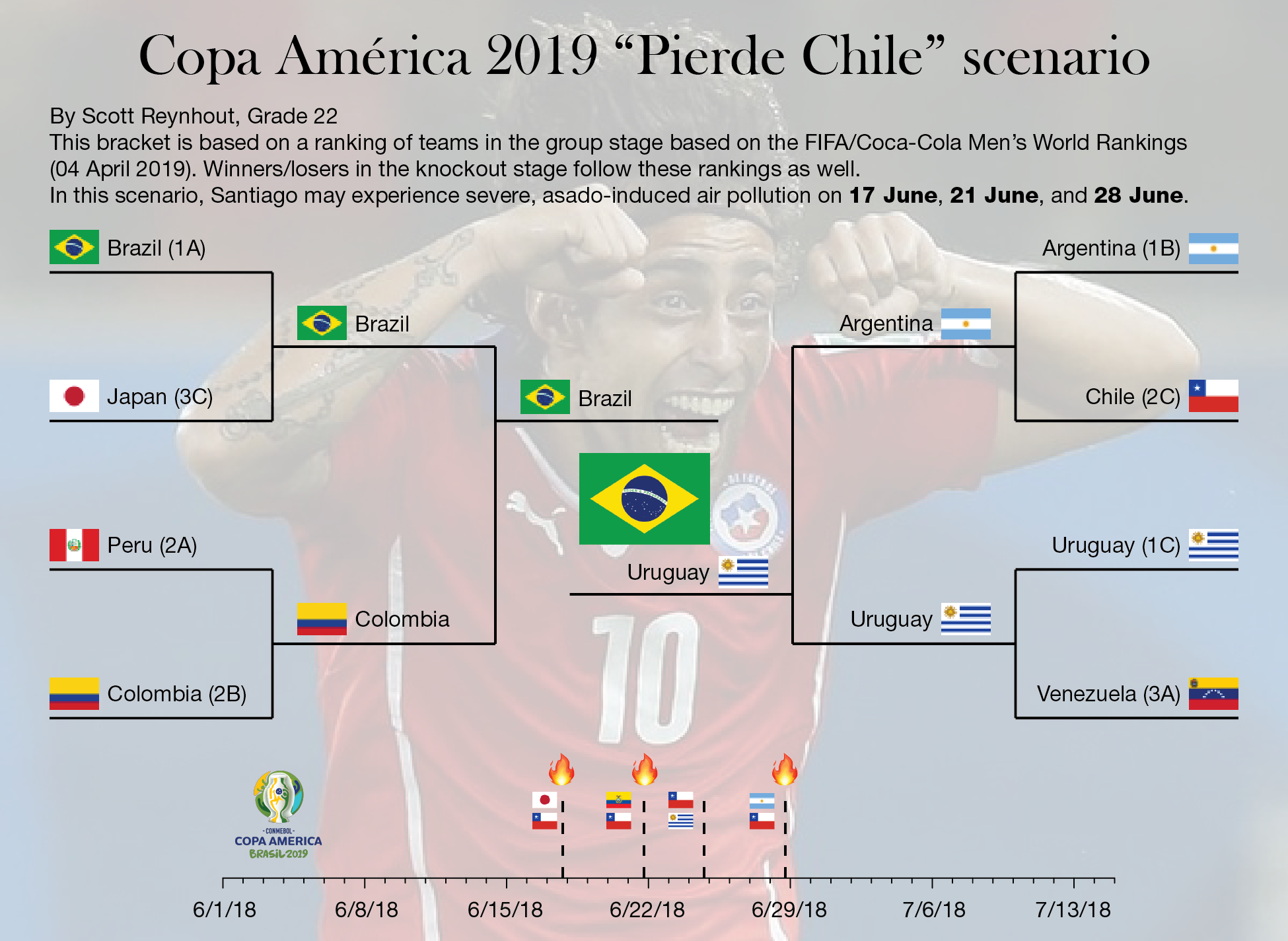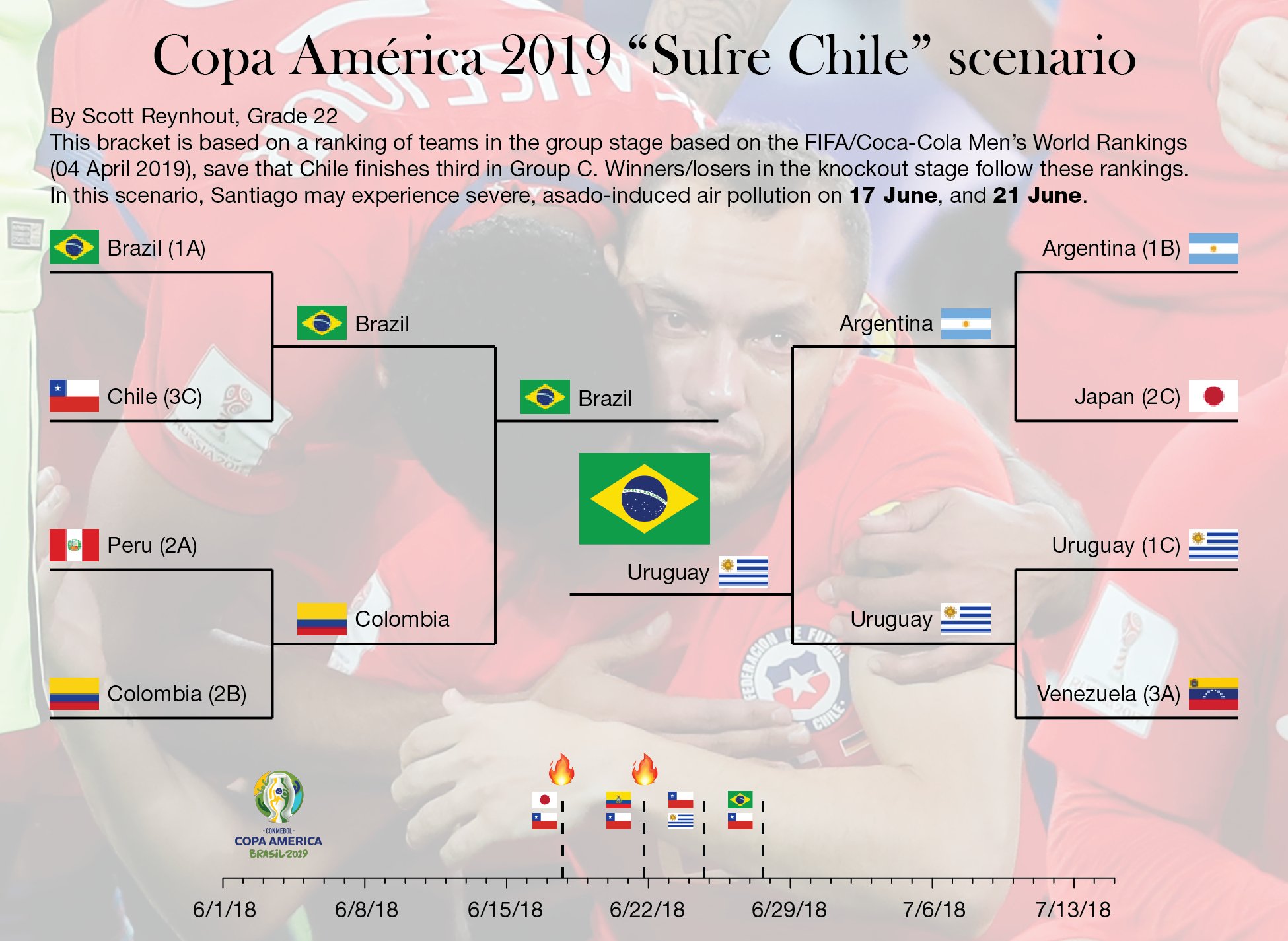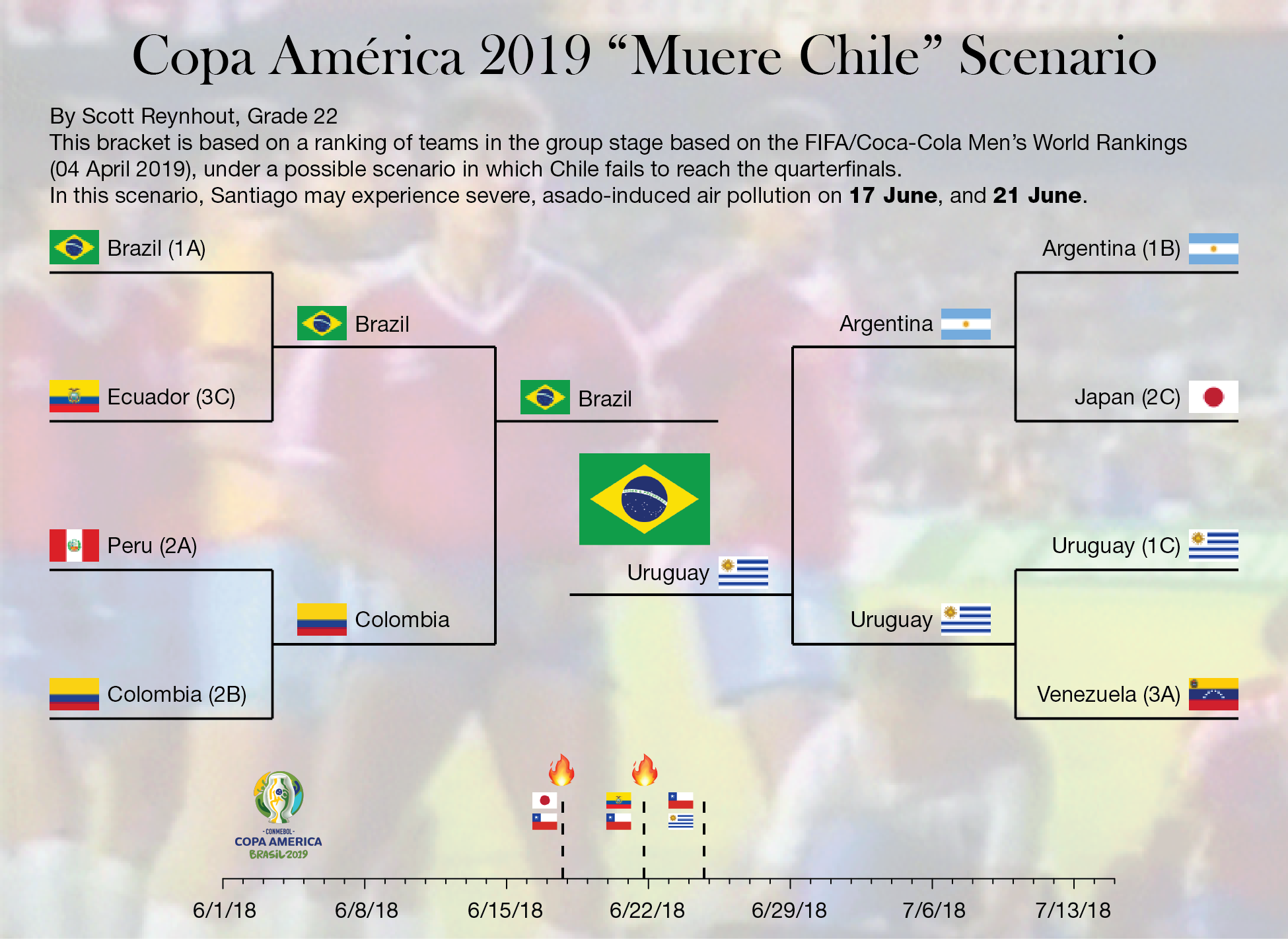One of the more absurd aspects about living in Santiago de Chile is the apparent association between extreme air pollution and games of the Chilean men’s national football team, mediated by…barbecues. Asados—Chilean barbecues—are an integral part of local football culture, but could be responsible for turning Santiago into an ashtray during game days. This link has been repeated by the Ministry of the Environment, the ex-intendant of the Región Metropolitana, and is now the subject of actual research by the Center for Climate and Resilience Research. Although the “asado effect” was essentially forgotten about after Chile failed to qualify for the 2018 World Cup, it is in the news again given Chile’s participation in this year’s Copa América. Here I attempt to explain the phenomenon and make some predictions for Santiago during this year’s Copa. Acompáñame.
tl;dr Yer gonna die if it’s dry on the 14th and 21st of June—and maybe the 29th of June and the 7th of July if Chile doesn’t suck.
What is the “asado effect?”
The idea is that thousands of households grilling meat simultaneously can provoke apocalyptic levels of air pollution. The classic fuel for the Chilean asado is wood or charcoal, which pollute much more than propane—it’s like setting a miniature forest fire on your patio. So far studies have not been able to directly measure these alleged barbecue emissions. Rather, the purported “asado effect” is based on measurements of air pollution throughout the city of Santiago, and their coincidence with games of La Roja (the Chilean national team).
Below, I’ve compiled measurements of fine particulate matter from a station in western Santiago, Chile, for June-July from 2014-2016. In red are hourly measurements of fine particulate matter, known as “PM2.5,” which refers to airborne particles with a diameter of less than 2.5 microns—these are demonstrably bad for your health. June-July is the international break in the football world, and is when all major international competitions take place. During these time periods, fine particulate concentration reached extreme levels three times.
Interestingly, these events correspond to games of the Selección Chilena.
June 13, 2014 corresponds to Chile’s debut in the 2014 World Cup against Australia.
June 18, 2016 marks the date when Chile ended México in the Copa América Centenario.
June 26, 2016 was Chile’s final victory against Argentina.
It’s difficult to explain these peaks by other, more traditional means. They occur outside the regular 9-5 workday, so it’s not likely it’s increased industrial emission or the likes. It’s also unlikely that everyone in the city decided to forego watching the game to just drive around the city this time (anecdotally, the streets are pretty much empty during matches). The most likely of the unlikely sources, therefore, are asados. You can read more about the phenomenon here—it’s important to know that the effect is felt very unevenly throughout Santiago, with the strongest effects in the lower western sector of Santiago.
While a number of other games also coincide with peaks in air pollution—such as the group stage in 2015—many other games do not show such an obvious effect. So, there must be other factors at play that determine when the “asado effect” comes into play.
Other factors?
The trick here is to attempt to quantify a) when would I have the time and motivation to hold a barbecue, and b) what are the meteorologic conditions that would trap my barbecue smoke close to ground level? In a previous post, I proposed that date, time, and relative humidity were the other factors influencing the likelihood of an “asado event” occurring. The first two have to do with the likelihood of making the considerable effort to put together an asado; the second is but one component of a number of climate effects governing overall air quality in the city of Santiago.
Timing. Two components here. First, it’s more likely to throw a barbecue on the weekend than the weekday (this is at least true for me). Second, you can’t have a gameday barbecue if kickoff is during the workday, or at 7AM Sunday morning. The ideal days for toxic asados, then, are Friday evenings, Saturdays after noon, and Sundays after noon. These are shown in yellow in the figure to the right. This fits pretty well with our three extreme events mentioned earlier, which occurred on a Friday evening, a Saturday evening, and a Sunday afternoon.
Relative humidity. Santiago—sitting in a bowl-shaped depression—is prone to temperature inversions, when cold air pools close to the surface and does not mix with warmer air higher up. If there is no wind to “stir the pot,” this cold air stays at the surface, and all the gases we fart out into this cold layer stays with us, too. The meteorology behind this is fascinating—strong inversions are most commonly associated with the development of an offshore coastal low that depresses the inversion layer below that of the Coastal Cordillera—but is totally beyond me to analyze in detail. While there are sophisticated models capable of predicting the behavior of the inversion layer far in advance, looking through the station data I noticed there’s a correspondence between low humidity days (expressed as % relative humidity) and high pollution nights. I’ve highlighted days with a minimum value of relative humidity of less than 50% in red at the right.
When it’s a Friday/Saturday/Sunday/Feriado and the relative humidity is low (orange above, or shown in blue at right), these provide conditions ideal for the development of heavy, asado-related pollution events if a game falls on these dates.
These criteria successfully reproduces the three really bad days mentioned above, and also “predict” spikes associated with other games (vs. Bolivia 2015 and 2016). Perhaps more importantly, it provides a way to explain why not every game is associated with an asado event. Matches of the 2010 World Cup took place on weekdays; moreover, due to the time difference kickoff was relatively early in the day. The 2017 Confederations Cup was even worse, being in Russia—and when games did occur on weekends, the meteorological conditions were not favorable for the development of extreme pollution. Also, nobody cares about the Confederations Cup.
The scheme fails to capture a few events (vs. Colombia and vs. Ecuador in 2015), and also falsely suggests extreme pollution for two pretty important gamedays (vs. Brazil in 2014, and vs. Argentina in 2015). While the Brazil game could be explained due to the early local kickoff time (noon on Sunday), I know from personal observation that there was a shit-ton of grilling done for the 2015 final vs. Argentina. Some other factor is at play here, likely due to the failure of relative humidity alone to capture the dynamic nature of the inversion layer.
Interestingly, these criteria—day of the week and RH—seem to coincide with certain events not associated with games. Big spikes in PM2.5 in 2011, 2012, and 2018 occur on dry weekends when the Selección Chilena was not involved in any international competition. I think it’s possible that this “weekend effect” could be a signatures of asados as well—after all, it’s not that difficult to come up with some random-ass excuse to invite your friends over for a barbecue.
Okay—you’ve convinced me, the “asado effect” is real. What about this year?
Well, in addition to those factors mentioned above, this also depends on how badly Chile suck going forward.
This year’s Copa América takes place in Brazil, meaning all matches will take place in the afternoons or evenings locally—primetime asado time. However, there’s no guarantee Chile will be a participant throughout the tournament. La Roja has not exactly dazzled in international competition this year: losing to México, drawing to the USMNT (shocking!), before struggling to defeat Haiti in their last match pre-Copa. In group C, Chile will face an aging yet in-form Uruguay, a deceptively strong Japan side, and Ecuador. While we should make it to the knockout stage no game is necessarily a “gimme,” and it is entirely foreseeable that we could crash out at the group stage.
Therefore, the potential asado days are governed in part by how far Chile advances in the bracket. I propose two scenarios below:




In the “Gana Chile” scenario, the first game vs Japan (Monday, June 17) could be a big barbecue day. This is analogous to the game vs. Ecuador in 2015, which fell on a Thursday but nonetheless coincided with a significant spike in air pollution—there’s probably a “first game of the competition” effect going on here. Additionally this year’s match vs. Ecuador (Friday, June 21) falls on a Friday evening, which should be terrible given the proper climate conditions. Assuming we finish second in Group C, we will face the winners of Group B—most likely Argentina—on Friday, June 28, which should also be an awful day for air quality if the inversion is strong. The semifinals fall on a weekday, which in 2015-2016 did not result in an air pollution spike, so I’m not predicting one here. However, the finals—in the unlikely scenario that we make it that far—fall on the afternoon of Sunday, July 7, which also could be pretty bad.
The more likely scenario has Chile knocked out of the quarterfinals by Argentina, resulting in potentially bad days on only June 17, June 21, and June 28.
In the scenario in which Chile reaches the quarterfinals in third place, we would face the winners of Group A—likely Brazil—on Thursday, June 27. I view mass asado as unlikely on this day, as knockout matches from Monday-Thursday don’t typically have spikes, so the only potentially hazardous days should be June 17 and June 21. In the extremely unlikely event that we defeat Brazil and (probably) Colombia to reach the finals, again the date of the finals (July 7) could be bad.
If Chile fails to reach the knockout stages—the only days of potential concern are June 17 and June 21.
Well, shit. Do I need to worry and hope Chile “se saca la chucha”?
Probably not. It’s important to understand that air pollution doesn’t kill you like you think it does: PM2.5, in particular, is most strongly related to cardiovascular mortality (PDF). This relationship depends most strongly on long-term rather than short-term exposure, which is one of the reasons why the prolonged “weekend effect” seen above is of great interest. In the grand scheme of things, two or three very bad evenings of barbecue won’t really affect your health when compared to the smaller, but more persistent PM2.5 emissions from cars and buses. In terms of health outcomes, I’d probably be more worried about the effect the choripán and piscola will have working its way through your system.
However, in addition to PM2.5, barbecues emit a good deal of other things—such as volatile organic carbons and sulfur compounds—that can exacerbate an existing sensitivity, such as asthma or COPD. In that sense, it might be wise to take measures to protect yourself. I’ve made a handy little guide (to the right) to help you determine whether or not a game might be associated with an extreme barbecue event—you can get relative humidity predictions from these sites—or, you can just ask your neighbor if they’re having a barbecue on match night.
What should I do? I can’t live without smoking these meats!
Listen, I’m not going to be the one to kill barbecue in Chile. Again, periodic match-day related asados are likely not having a tremendous net effect on public health. However, if you are interested in being a better citizen, or if you live with someone sensitive to air pollution, you could consider the following actions:
Pay attention to the air quality advisories of the Ministerio del Medio Ambiente. I’ve laid out here a formula to predict bad air days from asados, but instead of listening to some rando on the internet, why not consult the experts? The Ministerio del Medio Ambiente in Chile has access to weather models that inform their predictions, and can tell you whether or not the conditions are ripe for extreme pollution in a considerably less chanta manner than what you’ll find here. You can view the air quality forecast for the following day here.
Stay indoors. The worst of the ambient air pollution, if it happens, occurs overnight. Staying indoors after kickoff will minimize your exposure to this—you’ll stay warmer, too.
Cook with gas (or electric). Propane grills burn considerably cleaner than traditional asados, and electric griddles don’t emit anything at all (in your kitchen at least).
If you can’t be convinced to convert to gas, at the very least prefer carbón (charcoal) over leña (wood). In addition to burning cleaner, charcoal burns hotter, making it a more efficient fuel for an asado.
Part of being human is balancing between things that are fun, yet demonstrably bad for you, and a healthily monastic existence of puritanical self-deprivation. Too much of either is, in my opinion, not healthy. And, with the aging of la Generación Dorada and the upcoming change to a 4-year format of the Copa América, it’s by no means certain we will ever see the Chilean team participate so intensely in international competition as we’ve seen over the last 5 years. So I say enjoy it while it lasts. Grill some meat. Grill some vegetables, if you don’t eat meat. Defy the intendencia. Drink up, stay up late, and vamos chilenos!



